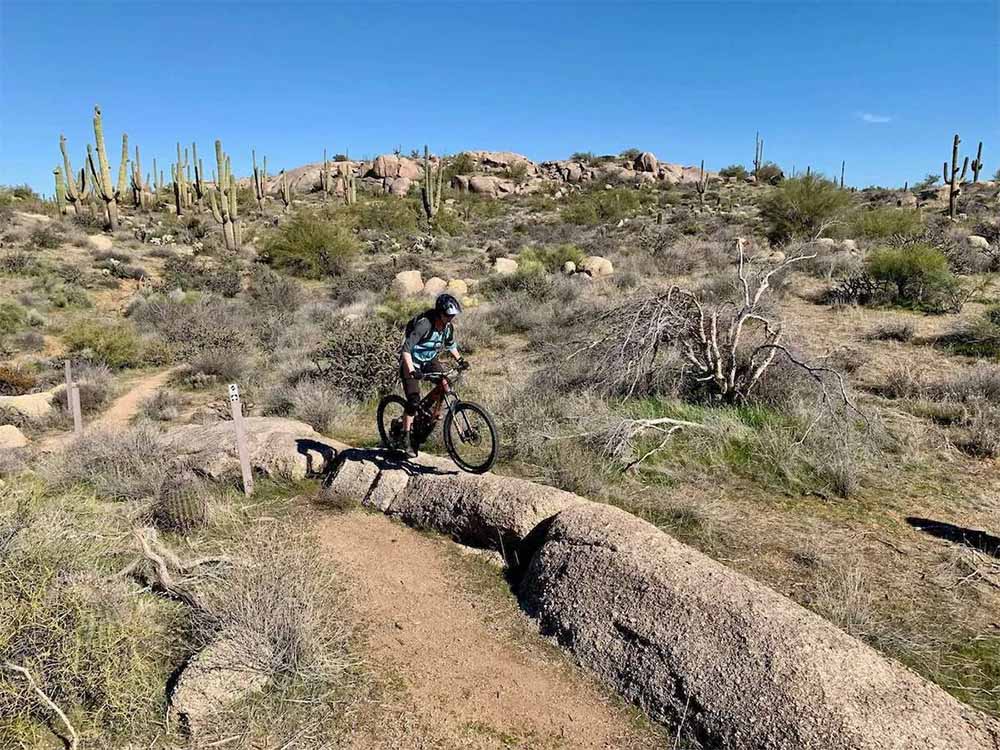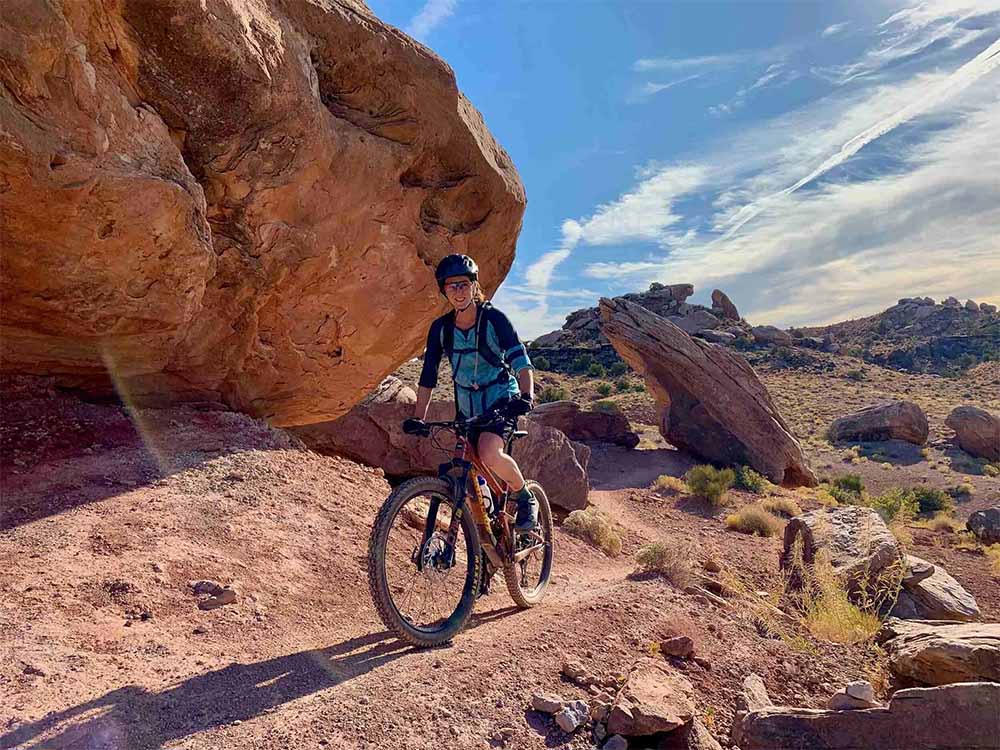10 Mountain Bike Tips for Beginners

Learn the best mountain bike tips for beginners so you can boost your confidence, hone your skills, and have more fun on the trails!
If you’re new to mountain biking, the thought of riding over rocks, roots, water droplets, and other trail obstacles may sound both exciting and terrifying. Even just trying to take a lap around the local trails can feel overwhelming. Mountain biking is definitely a sport where you can choose your own adventures that sometimes exceed our expectations. But with practice, patience, and a few mountain biking tips for beginners, even the most “terrifying” obstacles can be tackled in time!
So if you’re looking to build confidence, learn new skills and take your riding to the next level, you’ve come to the right place. These 10 mountain biking tips for beginners will give you a good foundation on how to start developing your bike handling skills and help you feel more comfortable in the saddle.
But like any sport, mountain biking is built on progress. The more you ride, the better you are! New to mountain biking? These 10 mountain biking tips for beginners will help you gain the skills and confidence you need to have the best time on the trails. Let’s ride!
1. Set up your bike correctly
When you get a new (or new) mountain bike, there are a few things you need to do to set it up correctly for your weight and height. Many new mountain bikers won’t do this, but it can make a huge difference in terms of comfort and confidence while riding. Here are two settings you should dial in before riding:
Suspension
Most mountain bike forks and shocks work with air pressure (unless you have a coil shock), and the proper air pressure depends on your weight. This is called sagging. In order to set the sag, you’ll need a shock pump to add air to your shocks, and you’ll also need to do some research to find out what psi is right for your weight. Some shocks will have chart labels on them for easy reference, but most do not. If you haven’t, you’ll need to go through some trial and error to set up your sag, and here’s a great video that will walk you through the process.
He also talks about two other suspension settings in the video: compression and rebound. All of this can be confusing at first, so I recommend starting with the sag—the most important setting—and then slowly start learning and dialing in the compression and rebound.
Seat height
If you’re wondering why your lower back or knees hurt when pedaling, or why it feels like you’re climbing Mount Everest, it’s probably because your seat isn’t the right height. Too high and you’ll strain your lower back; too low and it’s a killer for the knees and makes pedaling more difficult.
Proper seat height means your knees are slightly bent when the pedals are closest to the ground. This may mean that your feet are not touching the ground when you are in the seat, but this is normal.
2. Keep the body loose and elastic
easy to say, hard to do. But in reality, if you keep your body relaxed—especially your arms, shoulders, and knees—your bike becomes easier to handle and your ride feels smoother downhill and over trail obstacles.
To get started, keep these two points in mind:
Keep your elbows and shoulders relaxed by lowering your chest onto the handlebars. This makes steering easier and lowers your center of gravity.
Keep your knees elastic and wide, allowing your body to move independently of the bike. You may have seen pictures of mountain bikers with their hips away from the side of the saddle. This is what you want to fight for. This is called body-bike separation.
Your hands and feet will always (hopefully) be attached to the handlebars and pedals, but your hips and knees should move independently of the bike. This will allow you to maneuver around turns, increase your speed and hit larger features with more confidence.
Learn the best mountain biking tips for beginners so you can boost your confidence, hone your skills, and have more fun on the trails!

3. Remember motivation is your friend
Many riders new to mountain biking will rely on the brakes more than they need to. I get it, going faster than you fit in can be scary, but the truth is, when it comes to mountain biking, power is your friend.
Speed will help you navigate tricky rocky sections with ease, float confidently around corners, and even cruise through drops and jumps once you’ve built up your skill and confidence.
In fact, most mountain bike beginner crashes are because they don’t have enough speed. You may have seen videos of riders going over the handlebars or going down through rock gardens. This happens (usually) because power is lost and the rider cannot keep his balance.
So when you get into the more technical sections of the track, keep working hard to loosen the brakes and you’ll be surprised what power can help you through.
4. Shift early, shift frequently
I always suffer when I see riders trying to climb in too hard gears, so one of the biggest mountain biking tips for beginners is to shift gears early and often.
If you see an uphill coming, downshift before the uphill begins. You don’t want to shift gears on a climb, because that can damage the drivetrain, possibly even a dropped chain, or worse, a broken derailleur. If you change gears before the start of the climb, you’ll have an easier and more enjoyable ride to the top.
The same goes for decline. Shift into a harder gear so your legs don’t spin a mile per minute when you get to the bottom of the mountain.
Pro tip: Most shifters are set up to allow you to “depress” a gear and drop three gears at a time. This is great for quick and powerful climbs when you don’t have time to downshift one gear at a time.
5. See where you want to go
This mountain biking trick for beginners may seem simple, but it’s worth mentioning because it’s so important. Keep your eyes forward and see where you want your bike to go. If you are on a large berm, look for the exit. If you hit a small drop, look at the landing. If you are on a straight, look straight ahead.
By finding where you want to go, you are setting your body position to guide your bike in that direction.
It’s also important to remember mountain biking tip #2 here – keep your body relaxed so you’re not fighting yourself. Stiff arms won’t make it easy to steer the bike in your desired direction.
Learn the best mountain biking tips for beginners so you can boost your confidence, hone your skills, and have more fun on the trails!
6. Ride with someone better than you
It might sound scarier than the first drop that sent you, but riding with someone better than you will make you a better rider.
Don’t worry about “blocking them” and don’t worry about going the technical part. Most mountain bikers are just excited to get out and ride some trails with a fun bunch of people – including you!
Riding with someone better than you also gives you the opportunity to watch skilled riders and see how they move their bodies and bikes. You can learn a lot by observation.

7. Learn how to track the stand
If there’s one skill to learn that will instantly boost your confidence and mountain biking abilities, it’s a track stand.
The track stand basically stands on your bike in a stationary state.
Why is this important? For control and balance. Many features on the track, such as steep descents, sharp turns and technical climbs, require control and balance. If you can’t keep your balance on the bike at low speeds, you may tip over or need to put your foot down.
Athletics racks are easy to learn with a little practice. Try taking 5 minutes to work on your balance before each ride! Learn the best mountain biking tips for beginners so you can boost your confidence, hone your skills, and have more fun on the trails!
8. Control your bike
There are two ways to ride a bike. You can be an active rider or a passive rider. Passive riders let the bike take them down the trail, and they more or less sit back and enjoy the ride as a passenger. On the other hand, the active rider controls the bike and actively steers and maneuvers it around corners and through functions. If you watch professional mountain bikers handle their bikes, it’s clear they are the drivers and the bikes are completely under their control. They show no signs of being passive.
But as a new mountain biker, how can you control the bike? One way is to start using your suspension aggressively.
When you’re cruising the trails, your suspension will absorb trail chatter and make your ride smoother, which is what the shock absorbers are designed for. The front and rear shocks respond to the contours of the trail without you having to do anything.
But you can also actively use your suspension by compressing or pumping it in. This helps you maintain momentum, jump over rocks and roots, turn more smoothly and efficiently, lift the front wheel over obstacles, and more.
It takes some practice to master how to pump the shock and control the bike, but the more you practice, the smoother the ride will become. If you have access to a pump track, that’s the best place to practice, but you can also practice easily on the trails.
9. Choose a different line
One way to improve your mountain biker skills is to take different routes on the trails, especially ones you ride regularly. The obvious line is usually the “easiest” line, so if you want to get better and more confident as a rider, it can be helpful to look for a different line. Take a few minutes to identify a new route and give it a try!
For example, a good starting point is to go over rocks and obstacles instead of going around them. The more you switch on the track, the more skilled you will become.
10. Watch Mountain Bike Videos
If you’re like me, you can learn while watching. That’s why I love watching mountain bike videos, especially videos from professional riders. Seeing a visual of how a skill or movement is done makes it easier to replicate on the track, and of course practice!
Whenever I feel unsure, scared, or nervous while riding a mountain bike, I remind myself to take a deep breath, and breathe. It helps calm nerves, overcome anxiety, and build the confidence to try something new or intimidating. If I hadn’t stopped to take a deep breath, I’d definitely come across some features that I wouldn’t have!
I hope these beginner mountain biking tips help you gain the confidence to experiment on the trails. Like anything, the more you practice, the better you get, so keep these tips in your head and enjoy!
If you are looking for a new way of commuting or want a healthier lifestyle, we are here to help you. Visit our website to learn more about electric bikes and electric scooter or please leave information to us.
 Shuangye ebike
Shuangye ebike
